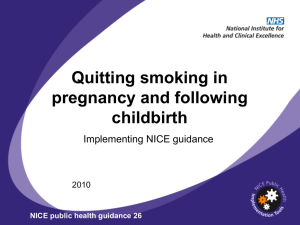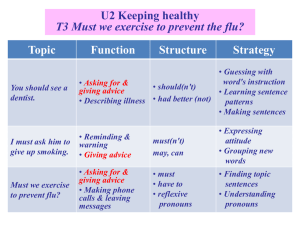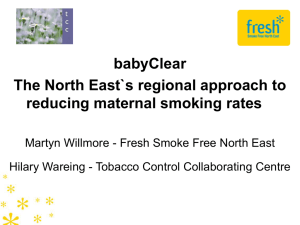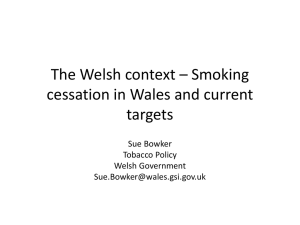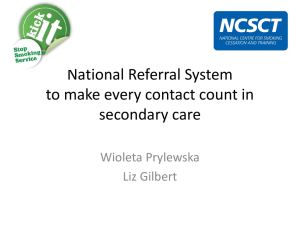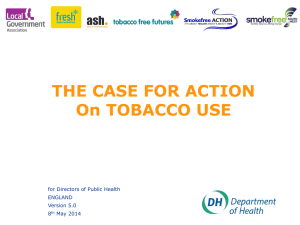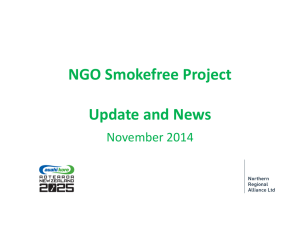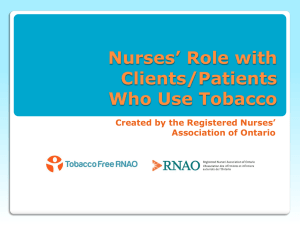Models for Access to Maternal Smoking Cessation
advertisement
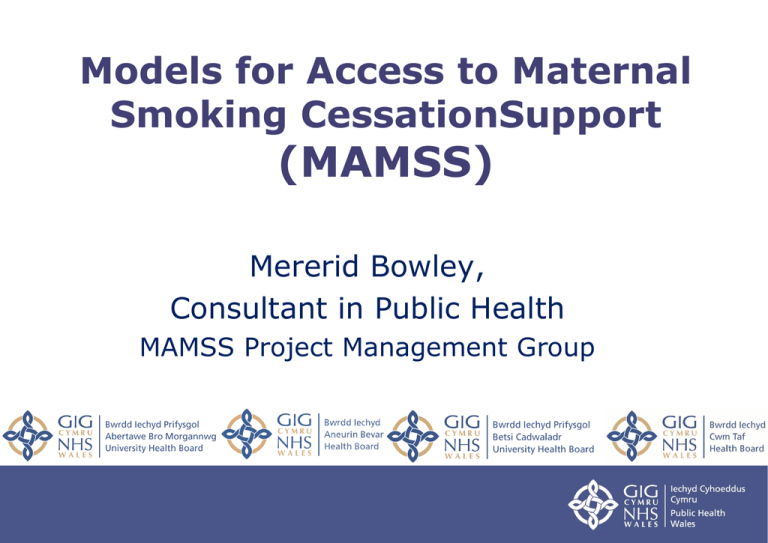
Models for Access to Maternal Smoking CessationSupport (MAMSS) Mererid Bowley, Consultant in Public Health MAMSS Project Management Group Prevalence of maternal smoking Inequalities in maternal smoking The first nine months can shape my future... Risks associated with maternal smoking Effectiveness of smoking cessation interventions in pregnancy Outcome Risk Ratio (Confidence Interval) 0.94 (0.93-0.96) Percentage reduction Low birth weight 0.83 (0.73-0.95) 17% Preterm birth 0.86 (0.74-0.98) 14% Smoking in late pregnancy Lumley et al Cochrane Database of Systematic Reviews 2009 6% Evidence base for maternal smoking cessation Recommendations for midwives: • • • CO Monitor Training Discuss health risks and refer all pregnant smokers (opt-out) Recommendations for NHS Stop Smoking Services: • • • • Flexible, client centred approach Address barriers to smoking cessation Feedback to midwives Intensive interventions and on-going support MAMSS Aims and Objectives Aim: To evaluate the extent to which improvements in the delivery of smoking cessation services to pregnant women can increase the proportion of pregnant smokers who engage with stop smoking services and reduce the number of women smoking during pregnancy. Objectives: • • • Fully implement NICE guidance for smoking cessation services for pregnant women in selected pilot and usual care sites Design and deliver different models of service delivery for smoking cessation services for pregnant women Compare the effectiveness of new models of service delivery with usual care Summary of project interventions 15th July 13 Challenges and limitations • Not a Randomised Control Trial • Different data systems used across the Health Boards – some are still paper based • A variety of different partners • Can only be part, not all, of the solution to maternal smoking Progress so far • Excellent integration between public health teams and maternity services in health boards with pilot sites • NICE guidance has been implemented across pilot and usual care areas. • Midwives have received brief intervention training and been issued with CO monitors • Early results from all project intervention areas are positive – Referrals from Midwives are higher than anticipated – Engagement and quit rates are higher than previous service delivery data ‘ I think the whole scheme is absolutely brilliant. The help and support that’s there helps and guides you to becoming a non smoker, and that benefits everyone, family and baby’s health.’ Rachel, Ruthin “I wanted to give up smoking for my lifestyle, my health and especially as I am pregnant. I want to ensure that my baby is healthy and isn’t breathing in cigarette smoke. I also want to be a good role model for my baby when it’s older and for others as well. I am feeling really good and much healthier. My skin feels better and I am drinking lots of water. I’ve also got more money which means I can buy the baby more things.” Natasha, Garth ‘Because Annmarie (Maternity Support Worker) came twice a week it meant that I wanted to do better. She helped me understand how to break my habits. My sister is pregnant and she has given up too.’ Sarah, Rhyl Acknowledgments • • • • • • • • • • • • • • • • Siobhan Jones – Chair Project team, Lead BCUHB Shantini Paranjothy – Academic lead, Cardiff University Lorna Bennet – Academic support Aimee Grant – Academic support Rachel Lewis – Project manager, lead BCUHB Mererid Bowley – Project Lead, ABHB Annie Petherick - Project Lead, ABHB Sarah Barnes – Project Lead ABHB Angela Jones – Project lead CTHB Margaret Munkley – Project lead CTHB Christian Heathcote-Eliot – Project Lead ABMU Catrin Jones – Project Lead ABMU Carol Owen – Stop Smoking Wales Ceriann Tunnah – Stop Smoking Wales Sharn Jones – midwifery rep Maternity Services Staff in BCU HB, CTHB, ABHB, ABMU Diolch yn fawr Thank you

